People often say to me “Oh, I can’t believe you do historic sewing. That must be so complicated!”. It really isn’t! Partly this is because it’s just a different skill set, but not a harder one, but partly because the shapes used for a lot of historic garments are actually pretty basic.
So what can you make with squares and rectangles and triangles?
The oldest extent garment is all squares and rectangles:
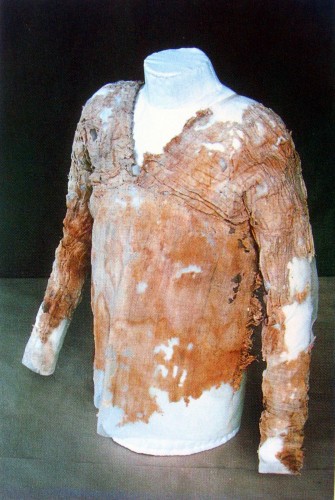
Pleated tunic, Ancient Egyptian. 1st dynasty, c. 3100-2890 BC. Werner Forman Archive/ University College London, Petrie Museum
As is pretty much every tunic and chemise since then, from the middle ages to the early 19th century:

Chemise presumed to have been worn by Marie Antoinette during her imprisonment, 101 x 83 x 67 Musee Carnavalet, Paris, France
Most petticoats are just rectangles of fabric pleated into waistbands:
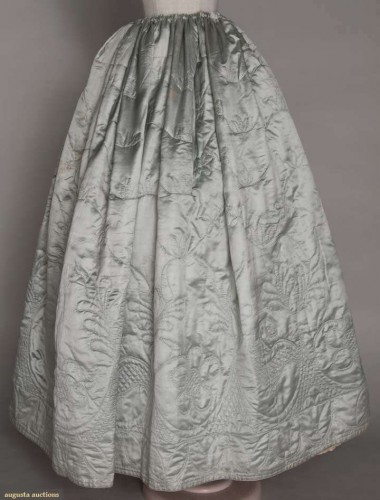
Quilted petticoat, 1770-1780s, silk satin with cream calamanco lining, Augusta Auctions
As are mid-19th century skirts, for all their tiers of rectangular ruffles:

Day dress, 1855, Centraal Museum
Fichus and handkerchiefs and buffons and neckerchiefs and pocket handkerchiefs (what’s the difference? I’ll be discussing them in an upcoming terminology post.) are all made of squares or rectangles or triangles:

Marquise de Grecourt, nee de la Fresnaye by Jean-Laurent Mosnier, ca. 1790
Muffs are essentially just layers of rectangles:

Evening muff, fourth quarter 19th century, American, fur, silk, Metropolitan Museum of Art
Many aprons are rectangles:
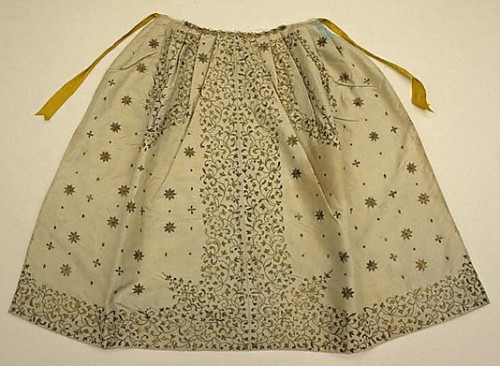
Apron, 18th century, British, silk, metallic, Metropolitan Museum of Art
As are many reticules, purses and variants thereof:

Bag, Great Britain, UK, Linen, silk, silver and silver-gilt threads; hand sewn, hand embroidered, hand plaited, V&A
Plus, there are all the ethnic costumes based on basic shapes (just remember if you make one of these is should still be pre-1938):
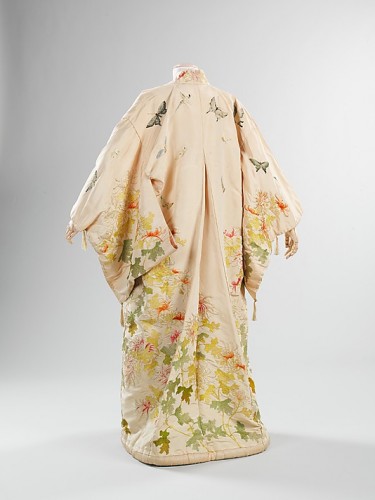
Kimono with Western influence, probably by Iida & Co.:Takashimaya (Japanese, founded 1831), ca. 1910, Japanese, silk, Metropolitan Museum of Art
And all the Western clothes inspired by these costumes:

Paul Poiret, ca 1920 Coat, sold by Beaussant Lefèvre
Vionnet loved to play with squares and rectangles, as in the ‘Chiton’ dress that I’ve replicated.
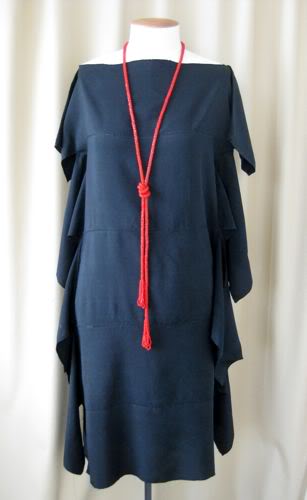
My version of Vionnet’s ‘Chiton’ dress
My Deco Echo blouse, while more historically plausible than strictly historical, is also made of squares and rectangles. And there is a full tutorial on how to make it if you want to make your own!
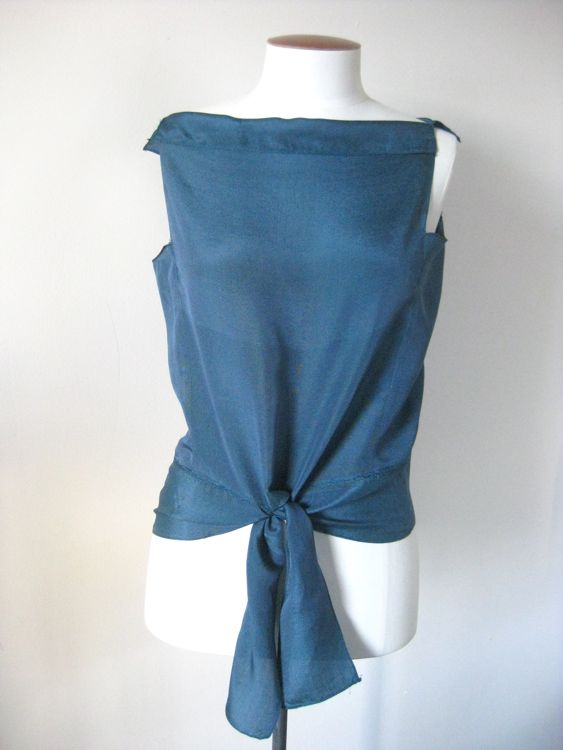
The Deco Echo blouse
So there are lots, and lots of options to make something that is based on squares and rectangles and triangles. What are you making?

Happy sighs. Amongst the other lovely things, that quilted petticoat is so desirable!
Thinking of squares and oblongs, Margery Allingham describes the ‘formula’ for making a monk’s robe – she has her fashion designer make one for her father from the formula laid down in the archives of a thirteenth century monastery.
“Of stout woollen cloth, take four equal pieces, each as long as the height of the Bro (sic, Brother), from nape to heel, and as wide as will stretch across his shoulders from elbow to elbow. Let the first cover his left breast and the second his right, and the third shall cover him behind. Then let the fourth piece be folded into three, and of these the first shall be for his left arm, the second for his right, and the third and last for his head. So shall he be covered and two ells of rope encompass his middle.”
Let’s hope the monks had nice soft linen ‘chemises’ undeneath – bet the wool wasn’t Merino! More like a training garment for hair shirts.
That’s a great monk’s robe description! 🙂
That’s quite a large amount of rectangular things, I shouldn’t have been so worried about this challenge.
I’ve got a 1780s petticoat that I’m planning to make that would fit the criteria. It has got a bit of a train in the back, but you said one curve allowed, right?
Oh my word. I would love that Paul Poiret coat as an abaya! It is so beautiful and modest.
All the costumes I have hand-sewn were made from rectangles and triangles. That’s great for using fabric economically.
I happen to own some authentic kimono and their basic rectangle patterns make it easy for me to resize them, even though my knowledge on sewing pattern is basically zero.
A fun fact: kimono are made from a long bolt of rectangular fabric (called a “tan”) cut into rectangles. Women used to “disassemble” their kimono, sew them back into one long rectangle, then float them in the river to wash them. Then they would sew the fabric into kimono again. I think that’s pretty interesting!
My challenge #11 project: Georgian/Regency era pantalettes for my daughter Jane. http://livingwithjane.blogspot.com/2013/06/historical-sew-fortnightly-challenge-11.html
Here is my post for this challenge. I made an apron and fichu for 18th century use.
http://cursewordsandcrinolines.blogspot.com/2013/06/hsf-challenge-11-squares-triangles-and.html?m=1
I fell off the bandwagon an missed the last challenge due to lack of inspiration but was able to pull it back together for this one. It was a fun surprising simple challenge that I really enjoyed 🙂
For this challenge I made a traditional Tunisian costume (or at least, the rectangular and triangular elements of it).
http://blacktulipsewing.blogspot.co.uk/2013/06/squares-rectangles-triangles.html
The 1920s dress hasn’t been abandoned; I’ve wanted to make this costume for a while, and the challenge just provided the perfect excuse to get on with it.
[…] drifted away from the HSF. While, at some point, I had plans for HSF #11: Squares, Rectangles and Triangles, and they were even written down somewhere, something like table clearing and recycling […]
[WORDPRESS HASHCASH] The comment’s server IP (72.233.127.210) doesn’t match the comment’s URL host IP (72.233.2.58) and so is spam.
Well, I wish I was working on my quilted petticoat; I forgot that was all rectangles. But I have been playing triangle, rectangle, square…without even remembering! http://kittycalash.com/2013/06/05/hsf-11-squares-rectangles-and-triangles/
And to think, I am making two of these! I thought I might get a shirt done, but osnaburg intervened. I’m glad to be back on the wagon, sort of, and look forward to future challenges!
Well, I wish I was working on my quilted petticoat; I forgot that was all rectangles. But I have been playing triangle, rectangle, square…without even remembering! (and havea sketch to prove it)
http://kittycalash.com/2013/06/05/hsf-11-squares-rectangles-and-triangles/
And to think, I am making two of these! I thought I might get a shirt done, but osnaburg intervened. I’m glad to be back on the wagon, sort of, and look forward to future challenges!
I made a large purple petticoat.
http://mouseborgdesigns.blogspot.ca/2013/06/purple-petticoat.html
So late, but here is the Bronze Age shirt…
http://caddamsbetraktelser.wordpress.com/2013/06/19/hsf-11-squares-rectangles-and-triangles-a-3000-year-old-pattern/
Better late than never finished! And what a fantastic project! Such an intriguing pattern – it looks so strange, but makes so much sense once you put it together. I actually prefer to ‘soft’ try projects like this – now you know exactly how big you want it to be, and how you want the sleeves to be, you can better plan for your actual weaving. Even ‘soft’, I am so impressed. And envious that you have Bronze Age tombs to walk past. Where I’ve lived 800 years is ancient, and even 200 is pretty darn exciting.
Better late than never! I’ve just posted about my apricot 18th century petticoat for this challenge.
http://quinnmburgess.wordpress.com/2013/07/02/belated-hsf-11-18th-century-apricot-petticoat/
Best,
Quinn
18th century workbag!
http://teacupsinthegarden.blogspot.com/2013/06/18th-century-silk-workbag.html